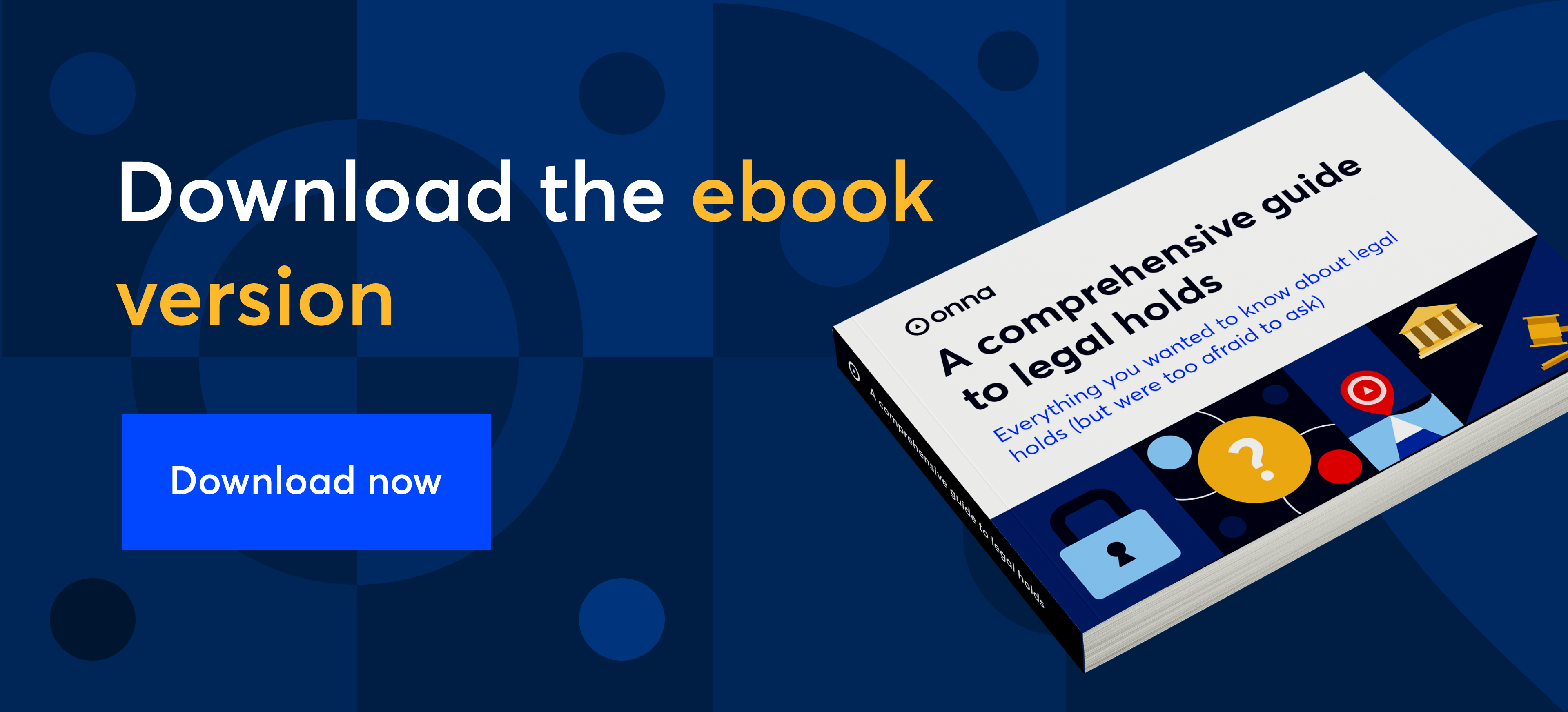A comprehensive guide to legal holds

Table of Contents
- What are legal holds, and why are they important?
- When are legal holds used?
- Why are legal holds used?
- Who is involved in the legal hold process?
- What types of information must be preserved?
- What should the legal hold process look like?
- What are some of the best practices for managing legal holds?
- What pitfalls should organizations avoid when implementing legal holds?
- What happens if a custodian deletes information subject to a legal hold?
- Need help establishing a sound legal hold process?
Whether you're the plaintiff or the defendant, it takes evidence to win court cases. That’s why preserving and protecting relevant information through legal holds is paramount.
If you’re a lawyer or an IT professional who feels a bit lost when it comes to legal holds, you're not alone. This comprehensive guide covers everything you need to know, from understanding the definition and significance of a legal hold to recognizing the responsibilities it entails and the risks of non-compliance. By the end of this guide, you’ll have a solid understanding of legal holds and will be well-equipped to navigate this essential aspect of the legal process.
Let’s start at the beginning: why do we care about legal holds, anyway?
What are legal holds, and why are they important?
Legal holds, also known as litigation holds or preservation orders, are crucial processes in the legal world. They are designed to ensure that all potentially relevant documents, data, and information are preserved when litigation, regulatory inquiries, or investigations are pending or anticipated. Their purpose is to prevent the destruction, alteration, or loss of evidence that may be significant in legal proceedings.
Legal holds apply to both electronically stored information (ESI), regardless of its format or storage method, and physical records, including letters, memoranda, notes, forms, calendars, and photographs.
Failure to implement and adhere to legal holds can result in what’s known as spoliation — the loss of information vital to resolving litigation. Spoliation can have severe consequences, including financial and evidentiary sanctions, loss of evidence for use in your case, and even an adverse judgment.
When are legal holds used?
Legal holds are implemented when there is a reasonable anticipation of litigation, a regulatory investigation, or other legal proceedings. When an organization becomes aware of potential litigation on the horizon — for instance, upon receiving a demand letter or becoming privy to an incident that could lead to a lawsuit — it should promptly implement a legal hold. This action ensures that relevant information is preserved from the early stages, safeguarding critical evidence.
Even when parties receive no advance notice, once litigation is initiated, all parties involved have an obligation to preserve information. This responsibility falls on both plaintiffs and defendants, as well as any third parties or custodians in possession of relevant data. Legal holds should be put in place to ensure the preservation of information throughout the entirety of the legal proceedings.
Legal holds also come into play during government investigations, where regulatory bodies request the preservation of specific records or data related to their inquiries. Failing to preserve this information can result in serious consequences and potential legal ramifications.
Why are legal holds used?
Legal holds are essential for various reasons:
- Preserving evidence: The primary purpose of legal holds is to prevent spoliation, which refers to the destruction, alteration, or loss of potentially relevant evidence. This ensures that all relevant information, both physical and digital, is preserved for use in legal proceedings.
- Improving compliance with legal and regulatory obligations: Many government agencies and jurisdictions have laws and regulations that mandate the preservation of evidence when litigation is anticipated or underway. Non-compliance can lead to sanctions, adverse rulings, and other legal penalties.
- Making discovery more efficient: By preserving evidence, parties can efficiently exchange relevant information, reducing legal costs and delays.
- Ensuring a fair legal process: Legal holds promote justice by ensuring that all parties have access to the same evidence. Without proper preservation, one party may gain an unfair advantage.
- Improving data security: Legal holds help safeguard sensitive or confidential information by preventing unauthorized disclosure.
- Maintaining an organization’s reputation: Properly implementing legal holds demonstrates a commitment to transparency and legal compliance, which can help uphold an organization’s or individual’s credibility.
Who is involved in the legal hold process?
Implementing and managing legal holds involves various responsibilities for all parties involved. Proper coordination and communication between legal counsel, IT staff, custodians, and any relevant third parties are crucial for ensuring the effective implementation of legal holds. Collaborative efforts help guarantee compliance with preservation obligations and mitigate potential risks associated with non-compliance.
Let’s take a closer look at the responsibilities of each group:
Legal counsel
Legal counsel is responsible for determining when a hold is necessary, ensuring its prompt implementation, and communicating the requirements to their clients or organizations involved in the litigation. They oversee the entire hold process, monitoring compliance and notifying custodians when they can return to their normal retention practices.
IT staff
The responsibilities of IT staff include identifying and preserving relevant electronic data, such as emails, documents, databases, and other ESI. IT must work closely with legal counsel to understand which data sources are potentially relevant and develop strategies for their preservation.
Custodians
Custodians are individuals who possess potentially relevant data. They are responsible for complying with legal hold instructions and ensuring that they do not alter or delete any data covered by the hold. Custodians should partner with their organization’s legal and IT departments and follow any outlined procedures for preserving information. They must also take reasonable steps to retain potentially relevant data, which could include suspending auto-deletion features or halting routine document destruction practices.
Third parties
In certain cases, third parties, such as cloud service providers, data centers, and data storage providers, may have relevant information subject to a legal hold. These parties have a responsibility to preserve the requested information and comply with the instructions provided by the involved legal counsel.
What types of information must be preserved?
Organizations should preserve various types of information when implementing a legal hold to ensure compliance with legal obligations and to be prepared for litigation, investigations, or regulatory matters. The specific types of information to be preserved may vary depending on the nature of the legal matter and the organization's industry.
Here are common categories of information that organizations should consider preserving:
- Emails: All emails, including sent, received, and deleted messages and attachments
- Documents: Digital and hard-copy documents, such as word processing files, spreadsheets, presentations, and PDFs from tools like Microsoft and Google Workspace
- Databases: Data stored in databases, including customer records, financial data, and transaction history
- Spreadsheets: Data and text in spreadsheets, not just cell values but also formulas, cell comments, and hidden sheets
- Calendars: Calendar entries, appointments, and meeting requests
- Instant messages: Records of conversations and chats from messaging platforms like Slack. This should also include relevant features such as emoji reactions, GIFs, and more
- Voicemail: Audio recordings of voicemail messages
- Social media data: Posts, messages, and interactions on social media platforms
- Audio and video recordings: Recordings of meetings, interviews, and other audio and video data, such as Zoom recordings
- Websites and social media: Archived webpages, posts, comments, and other online content
- Software and application data: Relevant data stored in software applications, databases, and specialized systems, whether these systems are locally installed or hosted in the cloud
- Contracts: All executed contracts, agreements, and legal documents
- Correspondence: Letters, memos, and other written communications
- Financial records: Invoices, receipts, ledgers, and financial statements
- Legal notices: Any legal notices or correspondence received
- Hard-copy records: Any physical documents, such as handwritten notes and printouts
- Metadata: Data about data associated with electronic documents, including creation and modification dates, authorship, and access logs
- Audit trails: Logs and records of actions taken within software systems, applications, or databases
- Documentation: Records of all actions taken to preserve information, including legal hold notices, acknowledgments, and compliance monitoring
Keep in mind that some of this data and documentation may be stored outside the company’s file systems and networks. You may need to include employees’ personal devices, such as laptops, tablets, and cell phones, as well as their email accounts if any of these are used for work-related communications and projects.
What should the legal hold process look like?
The legal hold process involves a series of steps to ensure the proper identification, preservation, and management of relevant information. Organizations should develop a policy that outlines the appropriate procedures, responsibilities, and timelines to follow when litigation is anticipated.
Here are the steps to include in your policy:
Step 1. Identify when a trigger event occurs
A trigger can be the filing of a lawsuit, a regulatory investigation, or any situation where litigation may be reasonably anticipated. Unfortunately, there isn't a bright-line rule defining what “reasonable anticipation” entails, but courts have determined that threats of litigation suffice. The receipt of a complaint or a charge from a regulatory agency more than qualifies.
Step 2. Determine what records may be at issue
The first step in tailoring your legal hold is determining how broadly you need to collect documents and data. Consider which records might be implicated in the matter. Remember that "records" are broadly defined; consult the list of information categories to brainstorm and identify potential data sources. After identifying the types of records in play, consider where this information is located and who might have custody of it.
Conducting custodian interviews can be a pivotal strategy at this stage. By speaking with those who have relevant information, you gain insight into both the details of the case and the locations of important records. Understanding where data has been created, sent, received, or stored allows you to refine the scope of your legal hold even further.
Step 3. Draft the legal hold notice
Legal hold notices should be clear and concise. The notice should specify the scope of the hold, the reasons behind it, and the consequences of non-compliance. Details to include encompass the nature of the dispute, key issues involved, the records that must be retained, and the time frame at issue.
Recipients must understand their obligation to halt any destruction of these records and should sign an acknowledgment of their intent to comply. The notice should outline the repercussions of non-adherence and include a reminder to maintain the confidentiality of the hold.
Conclude with details on whom custodians can contact with questions or for assistance.
Step 4. Distribute the notice
Legal should deliver notices to all potentially relevant individuals holding or overseeing pertinent information, including employees, third-party vendors, and contractors. Don’t forget to include your IT team on the distribution list so they can halt any destruction at the server and network levels.
Step 5. Educate custodians
Organizations should educate custodians about their responsibilities under the legal hold and provide guidance on how to comply. Establishing a channel for custodians to ask about their duties and clarify their responsibilities is pivotal.
Step 6. Monitor compliance
During this process, legal should actively monitor and audit custodian adherence to the hold, ensuring that data is preserved as required. Corrective action should be taken when necessary.
Legal should also maintain records of all legal hold communications, from sent notices to acknowledgments and custodian responses. Comprehensive documentation is vital for demonstrating compliance.
Step 7. Release the hold
A legal hold is no longer required once litigation concludes, a regulatory investigation ends, or legal counsel determines that the hold is no longer warranted. It’s critical to notify both custodians and the IT team so they can resume their normal information governance and records retention practices.
What are some of the best practices for managing legal holds?
Implementing a legal hold might seem straightforward, but it can be surprisingly complex, especially when your organization needs to manage multiple holds simultaneously. Besides, there’s so much at stake that you can’t be too careful. If you follow these best practices, you’ll be well on your way to compliance:
- Establish a written legal hold policy: Your policy should outline the procedures, responsibilities, and timelines for initiating, managing, and releasing legal holds. Review and update your policy annually to accommodate changes in laws, regulations, and organizational requirements.
- Conduct periodic training: Regular training and written guidance are crucial to ensure employees understand the significance of legal holds and their associated responsibilities.
- Keep detailed documentation of your hold: Keep all records pertaining to your legal hold, including notices sent, custodian acknowledgments, and any updates. The more comprehensive your documentation, the less likely that you’ll be sanctioned heavily if you make a mistake. Remember that the test isn’t perfection — it’s whether you acted reasonably and in good faith.
- Release the hold promptly: Once a hold is no longer needed, release it. This prevents over-preservation and mitigates potential information-related risks in the future.
- Conduct the records yourself: Allowing document custodians to gather their own records is a recipe for disaster. They aren’t trained to collect documents, and they may not understand how to avoid altering a document’s metadata. Ensure you have the tools or partners adept at collecting information in a forensically sound and defensible way.
- Turn to technology for help: Legal hold software can automate and streamline the often labor-intensive tasks of issuing, managing, and tracking legal holds. It can not only generate and send legal holds electronically but also monitor compliance, facilitate document identification and collection, and much more. Technology can also significantly assist in categorizing data for identification, collection, and eventual disposal.
What pitfalls should organizations avoid when implementing legal holds?
Legal hold procedures are inherently complex, with numerous moving parts. To ensure seamless execution, advance planning, effective organization, and frequent, clear communication are essential. Even in the best-case scenarios, challenges can arise. However, by being aware of them ahead of time, you may be able to ward them off.
- Overpreservation: Preserving too much irrelevant data can be costly and burdensome. Implement retention policies to dispose of information regularly and avoid data hoarding.
- Lack of comprehension: Be sure to communicate — early and often — about what custodians must do to comply with legal hold notices. Establish multiple channels for communication and support to ensure your message is conveyed effectively.
- Losing track of holds: Many organizations have multiple legal holds active at the same time — some of which have overlapping custodians and data. A manually maintained spreadsheet isn’t enough to keep track of preservation obligations, especially when it comes to releasing holds. Legal hold technology can help track multiple holds so you don’t accidentally release custodians from one matter, only to discover they’re connected to another.
- Inconsistent implementation: Ensure uniform application of legal holds across all custodians and departments. Track compliance to avoid the appearance of selective preservation, which can lead to accusations of spoliation. If custodians are nonresponsive, make sure you send and track reminders and escalate issues as necessary.
- Separated employees: Tracking employees who leave the company is challenging. Often, their records are purged, and their equipment is recycled after a set period. This can have significant implications for eDiscovery. Legal should partner with HR, keeping them informed about preservation obligations. Technology can also assist in tracking custodians and addressing changes in employee status.
- Cross-border matters: Issuing a legal hold might implicate international data privacy and protection laws. It's crucial to know where your data is stored using a data map and to ensure compliance with all applicable regulations, such as allowing individuals to request that their personally identifiable information be redacted.
What happens if a custodian deletes information subject to a legal hold?
Rule 37(e) of the Federal Rules of Civil Procedure addresses sanctions for failure to preserve ESI. This rule lists potential sanctions based on whether the failure to take reasonable steps to preserve evidence was intentional. When a party is prejudiced by the loss of evidence, courts “may order measures no greater than necessary to cure the prejudice.”
However, if a party intentionally destroys evidence to prevent another party from using it, the court may issue spoliation sanctions. The court may order an adverse inference, where a jury is instructed to assume that the destroyed or altered evidence would have been unfavorable to the noncompliant party. The court can also dismiss the action or enter a default judgment against the party. Monetary sanctions, including fines or awards to cover the costs incurred by the opposing party due to the failure to preserve evidence, are also possible.
Moreover, not preserving evidence can weaken a party’s case, leading to unfavorable judgments, settlements, or decisions in legal proceedings. Noncompliance with a legal hold can also damage the credibility of a party in the eyes of the court.
The long-lasting effects of spoliation may include reputational damage, affecting a party’s relationships with clients, investors, and the public. And, because legal professionals have ethical obligations to ensure the preservation of evidence, noncompliance can result in disciplinary actions by state bar associations or other professional bodies.
Need help establishing a sound legal hold process?
Legal holds are indispensable for preserving evidence and ensuring a fair and just legal process. Organizations should establish robust legal hold policies and leverage technology to streamline the process.
Get in touch to learn how Onna’s Integrated Legal Holds solution can help you simplify your legal workflows and manage your data.
 eDiscovery
eDiscovery Collections
Collections Processing
Processing Early Case Assessment
Early Case Assessment Information Governance
Information Governance Data Migration
Data Migration Data Archiving
Data Archiving Platform Services
Platform Services Connectors
Connectors Platform API
Platform API Pricing Plans
Pricing Plans Professional Services
Professional Services Technical Support
Technical Support Partnerships
Partnerships About us
About us Careers
Careers Newsroom
Newsroom Reveal
Reveal Logikcull by Reveal
Logikcull by Reveal Events
Events Webinars
Webinars OnnAcademy
OnnAcademy Blog
Blog Content Library
Content Library Trust Center
Trust Center Developer Hub
Developer Hub